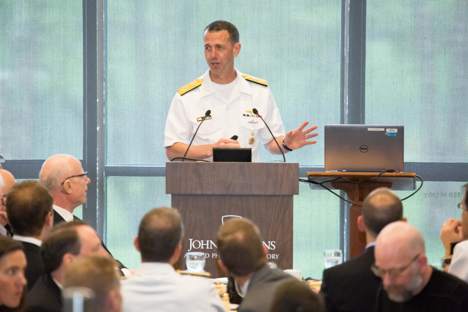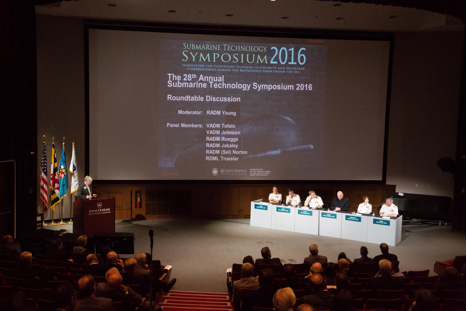Press Release
Submarine Technology Symposium Fosters Collaboration, Innovation

From its inaugural session in 1988, the Submarine Technology Symposium (STS), held annually at Johns Hopkins Applied Physics Laboratory in Laurel, Maryland, has been one of the nation’s premier technical conferences for developing platforms of collaboration across the undersea warfare enterprise — platforms that address critical technology challenges facing the future of the undersea domain. STS presents a unique opportunity for the U.S. Navy Submarine Force Leadership, research laboratories, industry, academia, naval acquisition, and the intelligence community to come together for three days of collaboration and discussion.
The 28th annual STS, cohosted by APL and the Naval Submarine League (NSL), was held May 3–5, and the sold-out gathering of more than 500 attendees attended technical presentations, interacted with hands-on exhibits and collaborated across the submarine enterprise on technologies designed to further enhance the submarine’s value to national and theater military commanders. “This year’s STS sellout attendance is an acknowledgment of the importance of our submarine force and the undersea warfare community in addressing the challenges to our country’s national security,” said the NSL’s Rear Adm. Charlie Young, USN (Ret.), STS general chair.
The 2016 STS, themed “Innovation for Continued Undersea Superiority and Increased Contributions across the Battlespace from Under the Sea,” included keynote addresses by Navy leaders, including Adm. John Richardson, Chief of Naval Operations; Adm. Frank Caldwell, Director, Naval Nuclear Propulsion Program; and Vice Adm. Dave Johnson, Principal Military Deputy Assistant Secretary of the Navy for Research, Development and Acquisition. Additional presenters included submarine force leadership such as Vice Adm. Joseph Tofalo, Commander, Submarine Forces; Rear Adm. Fritz Roegge, Commander, Submarine Force, U.S. Pacific Fleet; and Rear Adm. Chas Richard, Director, Undersea Warfare Division (OPNAV).
The first STS was held following a request by the commander of the Atlantic submarine force to help expand research and development efforts related to submarines, a role APL has fulfilled for the Navy since the 1960s. Since then, it has become a vital platform for the submarine force to share its vision and strategy with the technical community. The conference has hosted dozens of leaders from across domains, including guest speakers who provide insights from broader perspectives (such as publisher and Republican presidential candidate Steve Forbes, in 2001).
The continuing importance of STS to the Navy was highlighted in 2011 when Vice Adm. John Richardson, serving as Commander, Submarine Forces (COMSUBFOR) at the time, chose STS as the venue to roll out the new Submarine Force strategic document, titled Design for Undersea Warfare. A few years later, in 2015, Adm. Richardson returned to STS as Director, Naval Nuclear Propulsion; while at the symposium, Richardson was announced as the prospective Chief of Naval Operations (CNO) by the serving CNO, Adm. Jon Greenert. Despite the last-minute meetings and changes in busy schedules for both Adm. Richardson and Adm. Greenert, the leaders found time to present their keynote addresses at STS — a testament to the value of the STS platform to the undersea community.

The five technical sessions presented at STS this year were chaired by representatives from industry, laboratories, academia and the intelligence community. Presenting authors and exhibitors were selected by the STS Executive Committee — led by Rear Adm. Young and APL’s Lisa Blodgett, Force Projection Sector head, STS co-chair — from over 100 abstracts submitted. Abstracts were reviewed and judged on their technical quality and potential impact to the undersea warfare community. Each session was framed by a Navy speaker who tied that session’s content to the symposium’s theme and to their own operational experience. STS concluded with a roundtable discussion during which submarine force and U.S. Navy flag leadership responded to questions submitted by the STS audience.
Adm. Young expressed his deep gratitude to FPS’s Brad Wolf, the 2016 STS Program Chair, and to the symposium session chairs. “Mr. Wolf and the session chairs worked tirelessly to ensure the attendees heard relevant and interesting technical papers from a very diverse group of industry, government and academic experts,” Rear Adm. Young said.
“STS is a great forum to discuss potential technical solutions to major challenges in the undersea domain,” said Blodgett. “The keynote talks from senior leadership and the focused talks from fleet speakers provide excellent operational perspectives.”
“As a new APL staff member in 2009, STS presented a very unique opportunity for myself and others to hear force vision from the flag leadership, real-world operations from fleet speakers, and technology solutions from technical presenters all on the same day,” said Wolf. “I was delighted to be given the opportunity to be the program chair for STS 2016.” Planning for STS 2017 started immediately following the conclusion of STS 2016. Each year the STS Executive Committee evaluates the lessons learned from the symposium along with survey comments from attendees and strives to make the following year’s symposium better than the previous.
The next Submarine Technology Symposium is scheduled for May 9–11, 2017, and will be chaired by FPS’s Angela Sarich.